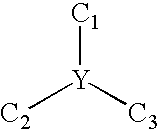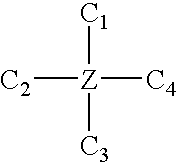Phase change ink compositions
a technology of phase change and ink composition, which is applied in the field of phase change (hot melt) ink composition, can solve the problems of sacrificing resolution and the inability to increase the size of the ejection orifi
- Summary
- Abstract
- Description
- Claims
- Application Information
AI Technical Summary
Benefits of technology
Problems solved by technology
Method used
Image
Examples
example i
Synthesis of Compound I, Tetraethylene Glycol Di-para-benzoic Acid
[0079]
[0080]Tetraethylene glycol di-para-benzoic acid is prepared in accordance with a procedure published by Alexander et al. (Polym. Prepr (Am. Chem. Soc., Div. Polym. Chem.) 1993, 34(1), 168-169), the disclosure of which is totally incorporated herein by reference, by reaction of ethyl-para-hydroxybenzoate with tetraethylene glycol di-para-tosylate. Thus 10 grams (19.9 mmole) of tetraethyleneglycol di-ρ-tosylate, 6.61 grams (39.8 mmole) of ethyl-ρ-hydroxybenzoate, 1.74 grams (43.5 mmole) of sodium hydroxide, and 120 milliliters of 2-propanol are charged to a 250 milliliter round-bottomed flask equipped with a TEFLON® paddle stirrer and a reflux condenser. The mixture is refluxed for about 10 hours, during which time a white precipitate is formed. The precipitate (sodium tosylate) is removed by filtration and washed with 2-propanol. The filtrate is then collected and solvent is removed in vacuo to yield an oily liqu...
example ii
Synthesis of Compound II, Tetrakis(4-pyridyloxymethylene)methane
[0081]
[0082]Tetrakis(4-pyridyloxymethlene)methane is prepared in accordance with a procedure published by Pourcain and Griffin (Macromolecules 1995, 28, 4116), the disclosure of which is totally incorporated herein by reference, by reaction of pentaerythritol tosylate with 4-hydroxypyridine. Thus, pentaerythritol is reacted stoichiometrically with tosyl chloride in pyridine to give pentaerythritol tosylate. Excess pyridine is removed in vacuo, the solution is diluted with cyclohexane, and pyridinium tosylate is removed by filtration. The filtrate is reacted with 4-hydroxypyridine in the presence of cesium carbonate to give the desired product, tetrakis(4-pyridyloxymethlene)methane.
example iii
Synthesis of Compound III, Pentaethylene Glycol-α,ω-dipyridine
[0083]
[0084]Pentaethylene glycol-α,ω-dipyridine is prepared by an analogous procedure to the procedure published by Pourcain and Griffin (Macromolecules 1995, 28, 4116), the disclosure of which is totally incorporated herein by reference, for the reaction of pentaerythritol tosylate with 4-hydroxypyridine. Thus, pentaethylene glycol di-ρ-tosylate (Aldrich 30, 958-3) is reacted with 4-hydroxypyridine (Aldrich 12,061-8) in the presence of cesium carbonate to give the desired product dipyridine.
PUM
| Property | Measurement | Unit |
|---|---|---|
| Temperature | aaaaa | aaaaa |
| Temperature | aaaaa | aaaaa |
| Viscosity | aaaaa | aaaaa |
Abstract
Description
Claims
Application Information
 Login to View More
Login to View More - R&D
- Intellectual Property
- Life Sciences
- Materials
- Tech Scout
- Unparalleled Data Quality
- Higher Quality Content
- 60% Fewer Hallucinations
Browse by: Latest US Patents, China's latest patents, Technical Efficacy Thesaurus, Application Domain, Technology Topic, Popular Technical Reports.
© 2025 PatSnap. All rights reserved.Legal|Privacy policy|Modern Slavery Act Transparency Statement|Sitemap|About US| Contact US: help@patsnap.com



